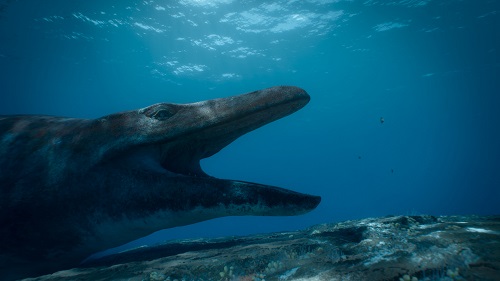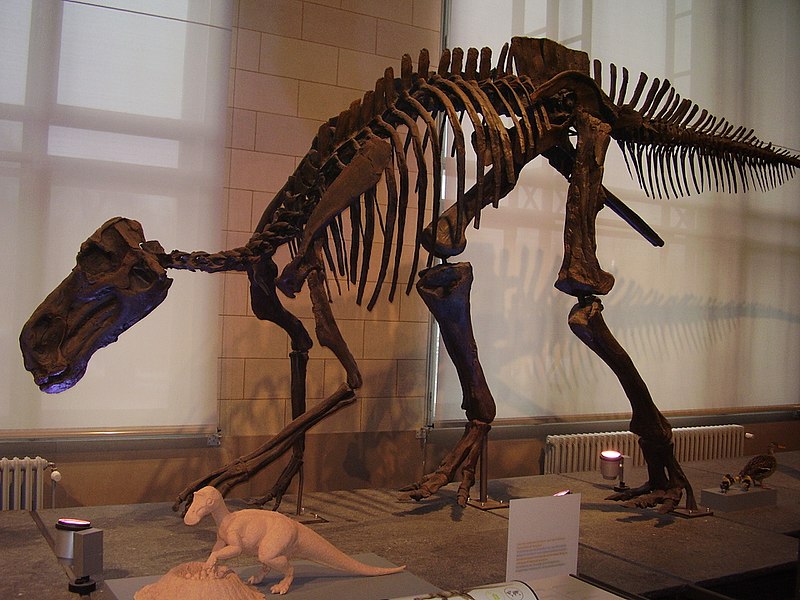Question: Why does T. rex have such a big tail?
Answer: The tail is a counterbalance, so the body doesn’t come crashing down.
Everyone knows this is the right answer. All the books in the volunteer library say so. We’ve been telling kids this since 1907 (or thereabouts).
You can do an experiment. Go to the Museum Store. Buy a plastic T. rex. Cut off the tail with your Leatherman. Watch the plastic T. rex fall. See? Case closed.
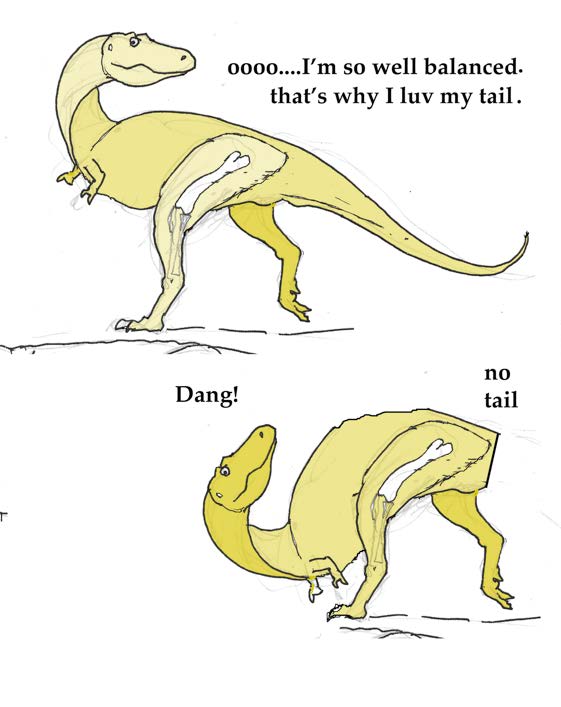 Dr. Bob does say that’s the right answer. But he also says it is the totally wrong answer.
Dr. Bob does say that’s the right answer. But he also says it is the totally wrong answer.
Dang PhD! Doesn’t he know we have to talk to 35 fourth-graders all at once in our Fossil Hall? We need simple, direct answers, not some sort of Talmudic rumination that goes around in circles and ties itself in knots like a philosophical pretzel.
Wait. He does make a good point or two.
First point: Dino tails were made of live bone and thick muscle, tissue that’s expensive for any animal to make. To grow his massive tail, a rex would have to eat lots more protein and minerals than what he would need if he were tail-less. Any rex who could do away with his tail would save 35 percent of his total food bill.
If the only purpose of the tail is to be dead weight that balances the body in front of the hips, it seems silly to build the tail out of such costly material.
Second point: Consider the turkey. Or a free range chicken or ostrich. Or Texas roadrunner. They are just as bipedal as a tyrannosaur or allosaur but they have hardly any bone or muscle in their stubby little tails (tail feathers are very light and inexpensive).
Go out to a farm and chase chickens and turkeys. Come to Seymour and try to catch a roadrunner as it zig-zags between the cactus. You will discover that these nearly tail-less critters run around and maneuver quite efficiently — and hardly ever fall over on their beaks.
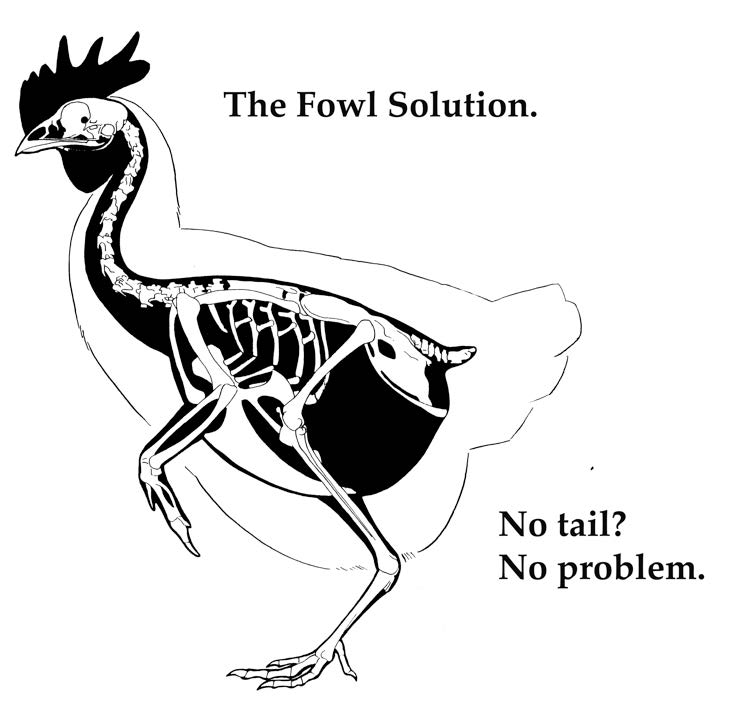 If evolution can make a bird who balances perfectly without a heavy tail, why would Darwinian processes insist on giving dinosaurs such wasteful rear ends? Let’s walk through the history of tails to see how function shifted over the last 380 million years.
If evolution can make a bird who balances perfectly without a heavy tail, why would Darwinian processes insist on giving dinosaurs such wasteful rear ends? Let’s walk through the history of tails to see how function shifted over the last 380 million years.
Stage One: The Earliest Amphibian, the First Vertebrate with Legs and Toes Fit for Walking.
We trust you’ve been watching “Your Inner Fish” on TV. Go read the book. It’s a great story about how the earliest four-legged fossils were dug in Greenland, stubby-limbed fellows named Icthyostega and Acanthostega. These species retained some very fishy features, like internal gills, tail fins designed for swimming, and heads that had no way to hear airborne sound waves. They did have thick, strong thigh bones (femora) with large joints for the hip socket and knee.
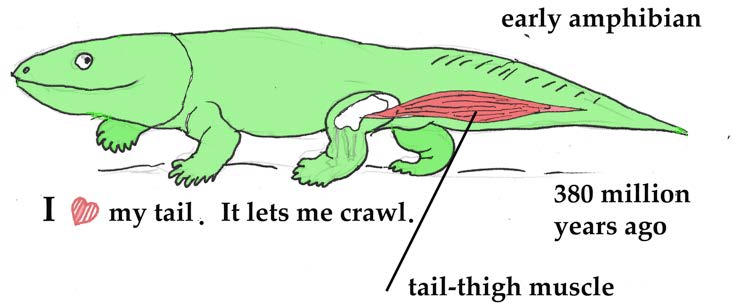 On the back of the thigh bone is a bump where a major muscle attached — it is the “tail-thigh muscle”, or, if you’re a fossil geek, you can use the Latin caudo-femoralis. Reptiles today have that muscle, as do salamanders.
On the back of the thigh bone is a bump where a major muscle attached — it is the “tail-thigh muscle”, or, if you’re a fossil geek, you can use the Latin caudo-femoralis. Reptiles today have that muscle, as do salamanders.
Next time you are in Grand Chenier, La., go to the Cajun restaurant and order gator tail. The big chunk of meat you are eating is the tail-thigh muscle. It’s immense. It attaches to the side of the tail bones and then runs forward to attach to that bump on the thigh bone.
(More fossil-jargon for paleo-nerds: muscle bumps on the thigh are labelled “trochanters”, and the tail-thigh muscle is hooked onto the “fourth trochanter.” No, I’m not going to explain the other three trochanters; if you must know, get Al Romer’s The Vertebrate Body).
When the tail-thigh muscle contracted in Ichthyostega , it pulled the hind limb back and pushed the body forward. In other words, the tail-thigh muscle was one of the main propulsive organs that let the earliest four-legged animals walk. Top speed wasn’t fast; more of a steady waddle.
Stage Two: Early Reptiles, about 300 million years ago.
Early reptilian legs were much longer than in the early amphibs, and the beasts were far more nimble. The tail-thigh muscle still was the No. 1 propulsive unit, pulling back on the fourth trochanter in every step. The end of the tail was very long and whip-like, so it could be used as a weapon to slap other reptiles or inquisitive amphibians who got too close.
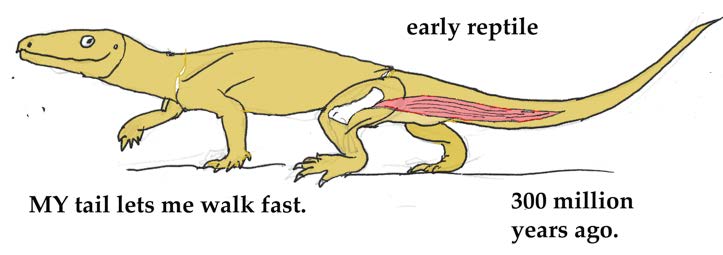 Stage Three: Land Crocs, Close Kin of Dinosaurs, about 210-250 million years ago.
Stage Three: Land Crocs, Close Kin of Dinosaurs, about 210-250 million years ago.
A major upgrade in running equipment came in the Triassic with the evolution of land crocs (technical label: the “suchia,” from the Greek word for croc). Land crocs did include the direct ancestors of today’s water-loving crocodiles and alligators, plus a dazzling array of land-lubbers. Leg action was even stronger than in the earliest reptiles, and the tail-thigh muscle was of great size.
Footprints show that most types of land crocs walked on all fours. However, the hind limbs were much, much thicker and longer than the front, so the tail-thigh muscle was dominant in thrusting the animals forward, with only a little help from the forelimb.
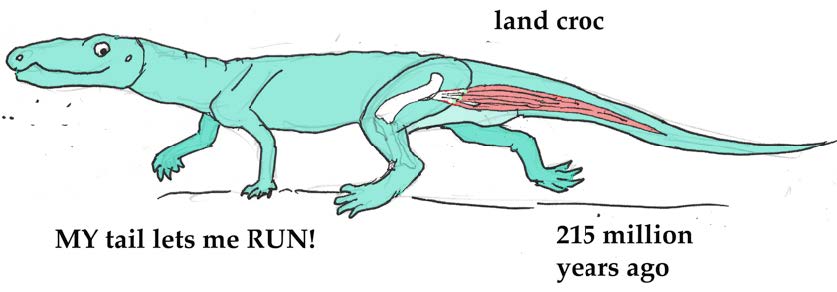 Land crocs filled the Middle and Late Triassic with a dynamic horde of adaptive variations — we have three examples in the Morian Hall of Paleontology. There were huge predators with heads over a yard long, armed with saw-edged fangs (Postosuchus), who used their hefty tail-thigh muscles to generate fast running speeds. And there were armor-plated plant-eaters (Desmatosuchus) who employed their tails to brace the forequarters when the up-turned snout was busy excavating roots and tubers. And there were immense fish-eaters with long snouts bristling with stabbing teeth up front and, in the rear, steak knife teeth for cutting prey (Smilosuchus and its cousin Rutiodon). These aquatic species developed deep, flat-sided tails that were useful for swooshing underwater, providing locomotion a la croc or a la gator.
Land crocs filled the Middle and Late Triassic with a dynamic horde of adaptive variations — we have three examples in the Morian Hall of Paleontology. There were huge predators with heads over a yard long, armed with saw-edged fangs (Postosuchus), who used their hefty tail-thigh muscles to generate fast running speeds. And there were armor-plated plant-eaters (Desmatosuchus) who employed their tails to brace the forequarters when the up-turned snout was busy excavating roots and tubers. And there were immense fish-eaters with long snouts bristling with stabbing teeth up front and, in the rear, steak knife teeth for cutting prey (Smilosuchus and its cousin Rutiodon). These aquatic species developed deep, flat-sided tails that were useful for swooshing underwater, providing locomotion a la croc or a la gator.
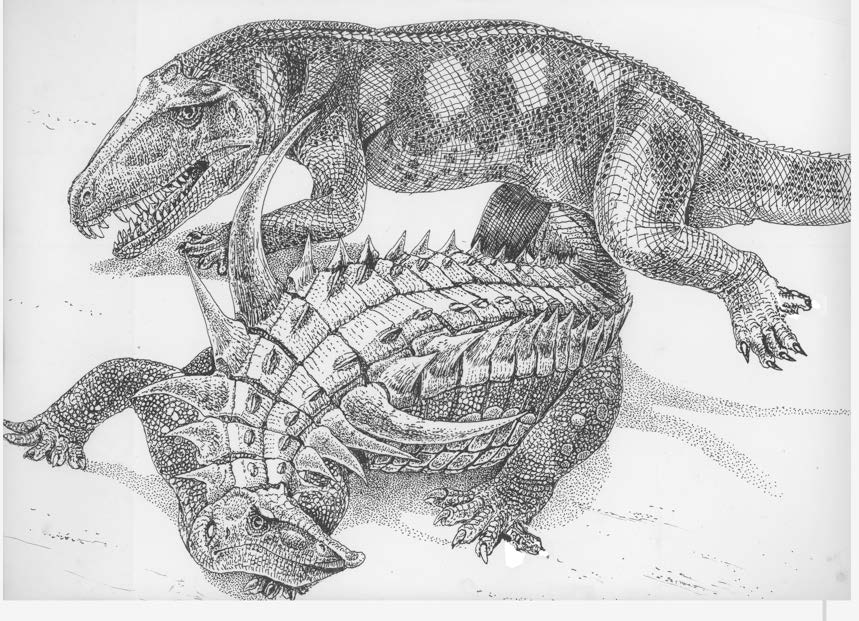 Here are two land crocs featured in our Fossil Hall. The spiky fellow is Desmatosuchus, an herbivore. The big-headed chap is Postosuchus, a predator. Both are common fossils in the Triassic Red Beds of Texas and adjacent New Mexico.
Here are two land crocs featured in our Fossil Hall. The spiky fellow is Desmatosuchus, an herbivore. The big-headed chap is Postosuchus, a predator. Both are common fossils in the Triassic Red Beds of Texas and adjacent New Mexico.
 And here’s Rutiodon, a land croc who modified the tail into a swimming organ. Our Smilosuchus is a close kin. The drawing is by the great S. W. Williston for his delightful book, Water Reptiles of the Past and Present. Williston did all his own illustrations — my hero!
And here’s Rutiodon, a land croc who modified the tail into a swimming organ. Our Smilosuchus is a close kin. The drawing is by the great S. W. Williston for his delightful book, Water Reptiles of the Past and Present. Williston did all his own illustrations — my hero!
Stage Four: Carnivorous Dinosaurs, about 200 million years ago.
The first genuine dinos evolved from a quadrupedal ancestor shaped like a Land Croc. The dinos took the trends in limb evolution to extremes. They reduced the size of the front legs even more, and increased the length and thickness of the hind. Voila! The early meat-eating dinosaurs were completely, unapologetically bipedal. Since the tail was already very heavy, it found employment balancing the forequarters.
My old professor Stephen J. Gould would label this event as an “exaptation.” That’s when an organ first evolves to fulfill some initial function — in this case, the tail-thigh muscle developed to power the hind limb stroke — and then, later, turns out to be useful in a new role: balancing.
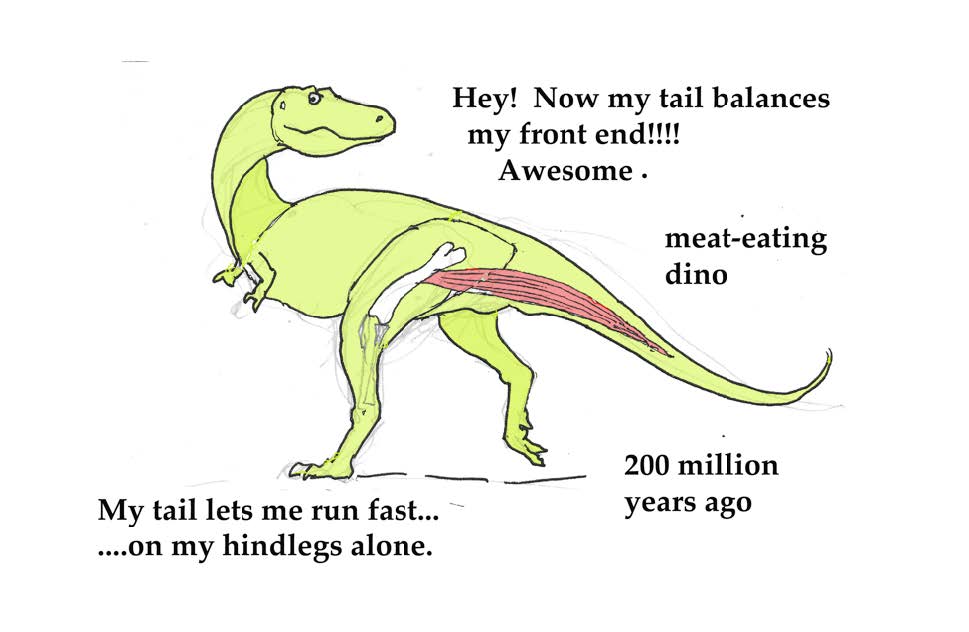 See! The long tail of bipedal dinosaurs did NOT first evolve as a counterbalance.
See! The long tail of bipedal dinosaurs did NOT first evolve as a counterbalance.
It first evolved in strictly quadrupedal animals, the earliest fishy-oid amphibian. The tail was the attachment for the tail-thigh muscle, a key unit of the hind limb stroke. The tail remained very important in walking and running in early reptiles and then in the close kin of dino ancestors, the quadrupedal land crocs. The first dinos were similar to land crocs except the hind legs were bigger and the fore legs smaller. Since they already had a super-heavy tail, the dinos were equipped to shift into a strictly bipedal style.
Yes, the T. rex tail served as a counterbalance. But all through the evolution of rex ancestors, going back to 380 million years ago, the tail’s main purpose had been as an attachment site for the super-sized tail-thigh muscle.
Where Night at the Museum Goes Wrong. And Black Labs Go Right.
I love the Night at the Museum movie, especially the T. rex skeleton that comes to life. However … the rex does illegal things. He wags his tail like a dinosaurian bloodhound or Labrador retriever.
Wrong. Since the tail-thigh muscle was thick and attached to the thigh, rex-like dinos couldn’t twitch, flip, wag or otherwise wiggle their tail with quick movements. Crocs and lizards have the same limitation: powerful sweeps of the tail are fine, but twitchy movements are impossible.
That’s why pet gators don’t wag their tails — even if you throw them a frisbee.
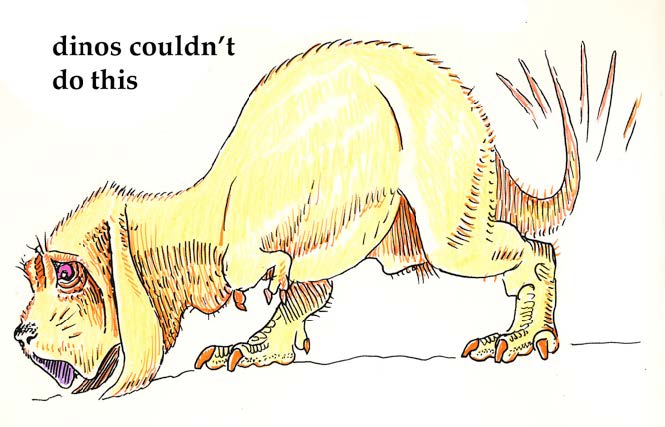 Hmmmmmmm … that brings up a mystery. We mammals evolved from an ancestor very close to Dimetrodon, the fin-back reptile of some 285 million years ago. D’dons had thigh bones with huge fourth trochanters, where the tail-thigh muscle attached. And that means the tail was linked to the hind limb and incapable of rear-end wiggle-ness.
Hmmmmmmm … that brings up a mystery. We mammals evolved from an ancestor very close to Dimetrodon, the fin-back reptile of some 285 million years ago. D’dons had thigh bones with huge fourth trochanters, where the tail-thigh muscle attached. And that means the tail was linked to the hind limb and incapable of rear-end wiggle-ness.
Modern mammals are weird. None of us has any connection between a tail muscle and the thigh bone, not even big-tailed species like otters, platypuses, pangolins * or giant red kangaroos. Somewhere between Dimetrodon and the earliest true mammal of the Triassic, our ancestors lost the thigh-tail linkage.
How can we tell when it happened? And how can we tell why it happened? It’s not a rhetorical question — I don’t know for sure. No one does. But I do have a hunch …
 *Don’t know what a pangolin is? “Scaly anteater” is another common name. Google it.
*Don’t know what a pangolin is? “Scaly anteater” is another common name. Google it.





